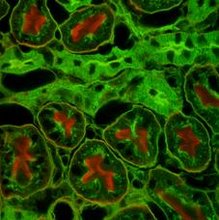Aim: -To perform PCR amplification of specific target sequence from genomic DNA.
Requirements: -
Thermocycler, UV transilluminator, D.W, Ethidium Bromide, Crushed ice/Genei cooler, Tips, Micropipette.
Principle: -
Polymerase Chain Reaction
Invented by Kary B Mullis
(Given Noble Prize in 1993)
It is a fast, inexpensive and cell free method of DNA cloning.
At the end of this method we get the multiple copies of targeted DNA sequence
Method: Three steps
1.Denaturation
2.Annealing
3.Extension
STEP 1: Denaturation
• Heat the reaction mixture at 94 ºc
• So, double stranded DNA molecule converts in to single stranded DNA
• ssDNA acts as a template for the primers and DNA polymerase
STEP 2: Annealing
• Reaction mixture is cooled at 50-60 ºc
• It allows the primers to anneal with the templates (two single strands)
STEP 3: Extension
• Temperature is again raised to 72 ºc
• So, Taq Polymerase adds new nucleotides and synthesize complimentary strands
These 3 steps are repeated 20 to 30 times in an automated thermocycler that can heat and
cool the reaction mixture in tubes within a very short time. These results in an exponential accumulation of specific DNA fragments ends of which are defined by 5’ ends of the primars. The doubling of no of DNA strands corresponding to the target sequence allows us to estimate the amplification associated with each cycle using the formula given below.
Amplification = 2n when n = no of cycles
PCR Can amplified a desired DNA sequence of any origin, 100s of millions of times in matter of hours, a task that would require days with recombinant technology. It is especially valuable because the reaction is the highly specific easily automated and very sensitive.
Factor affecting Amplification
Sample volume
Template DNA
Primers
Deoxynucleotide – triphosphate
Taq DNA polymerase Buffer
Taq DNA polymerase
Temperature cycling
Initial denaturation step
Denaturation
Annealing
Extension
Final extension
Procedure:-Setting up PCR
1. Add the following reagents to the PCR tubes in the following order
Sterile water 38 µl
10 X assay buffer 5 µl
10 mM dNTP mixture 3 µl
Template DNA (100ng/µl) 1 µl
Forward primer (100ng/µl) 1 µl
Reverse primer (100ng/µl) 1 µl
Taq DNA polymerase (30 ng/µl) 1 µl
Total reaction volume 50 µl
2. Mix the content gently and layer the reaction mix with 50 µl of mineral oil to prevent evaporation.
PCR amplification
3. Carry out the amplification in a thermocycler for 30 cycles using following reaction conditions
Analysis on agarose gel
Following PCR amplification add 5 µl of gel loading buffer to each of the PCR tubes.
Tap the mixture thoroughly and wait for a few records for the 2 layers to separate. Carefully pipette out 15 µl of reaction mixture (avoiding mineral oil layer) and load on to a1.5% agarose gel.
Load to 10µl of the ready to use marker provided. Note down the order in which the samples have been loaded.
Run the samples at 100 volts for 1-2 hours till the tracking dye (bromophenol blue) reaches ¾ th of the length of the gel. Visualize the gel under UV transilluminator.
Observation
Compare the Amplified band width 100 bp 100bp ladder and note down the size of the fragment. Also observe for presence of any other bands other than the amplified product.
Interpretation
PCR amplification of the template using specific primers results in a specific product of a particular length. The conditions have been optimized to give a highly specific product of 800bp as is observed by the absence of any non-specific products. Altering these conditions would result in non-specific amplification.PCR was carried out with 100 ng of template having appx. 1000 copies of the target sequence. Following PCR, the product yield is in µg quality, which is approximately a million copies of the target sequence, highlighting the fact that PCR is a very sensitive technique.
Subscribe to:
Post Comments (Atom)


2 comments:
Thanks for the great protocol on PCR amp.
PCR Tubes
Hello,
If you are needing pipetting for making up reagents, then disposable plastic graduated pipettes that can use a vacuum assisted drawing bulb or plunger would be ideal. This should be an option for you, as your costs and lab function helps make the decision.
Micropipette
Post a Comment